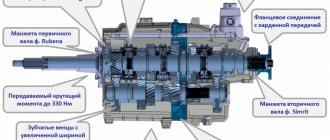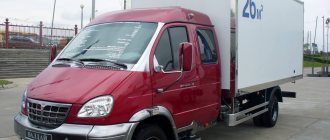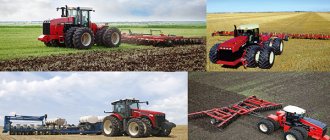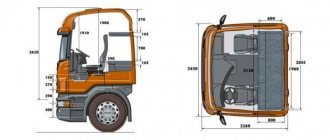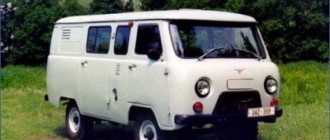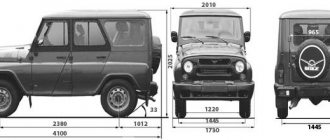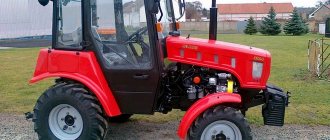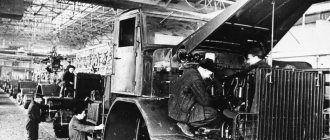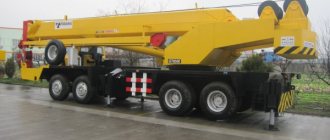Weight of ZIL-130 bodies
For most modifications of the ZIL-130, the calculated body weight varies from 3860 (kg) to 4575 (kg).
Body weight:
Truck body weight ZIL-130 (1963 – 1966): 4300 (kg).
Body weight of the ZIL-130V1 truck tractor (1964 – 1986): 3860 (kg).
Truck body weight ZIL-130G (1965 – 1986): 4575 (kg).
Features of model bodies:
The basic modification of the ZIL-130 includes an awning along with removable arches. The floor height of the ZIL-130 cargo compartment is similar to the floor height in railway cars, which optimizes the loading and unloading process.
Important: the first modifications of the ZIL-130 had two ventilation hatches in the cab roof and an air duct hatch on the left side of the cab above the clutch pedal.
Years of production years of production of all modifications of the model: 1962-2010.
| Total body weight ZIL 130 | |||
| General view General view of bodies | Bare body weight min (kg) Minimum body weight for different modifications of ZIL 130 | ||
Data are presented in kilograms (kg)
Caution: the data presented separately for the body are indicative, and may differ from the real ones by 15% in one direction or the other.
Source
Description of the cabin and its operational characteristics ZIL-130
The main mechanism in the ZIL-130 cabin is the steering wheel. It is a special screw with a ball-shaped nut. The solid metal cabin is designed for three people including the driver. It is located immediately behind the engine. For the comfort of the crew, the seats can be adjusted in different directions - height, length, tilt.
A distinctive feature of the vehicle is the presence of:
- heating device in the cabin;
- windshield wipers;
- mechanism for washing the windshield.
All instruments on a specially designed panel are located at a comfortable distance for the driver. In the upper part of the ZIL-130 cabin there are two ventilation hatches.
Steering mechanism with hydraulic booster ZIL 130
The comfortable stay of the crew inside the cabin was ensured not only by modern equipment for its time, but also by convenient dimensions. The cabin width has been increased to 1.2 m.
Thanks to the presence of a built-in hydraulic booster, controlling the ZIL-130 was significantly simplified. This technical solution also increased crew safety. Indeed, in the event of an emergency when the front wheel breaks, steering the vehicle has become possible, which has reduced the likelihood of serious damage.
Video on the topic: Review of Zil 130 agriculturalist
Publications on the topic
Instructions for self-adjustment of ZIL 130 valves
Technical characteristics and design of ZIL 157
Technical characteristics and general description of the T-130 bulldozer
Recycling process
It is worth remembering that recycling a vehicle is not only about getting rid of old metal, but also about receiving additional money for materials. Recycling also helps preserve the environment, since car materials are not naturally recycled. Some owners sell high-quality parts to other owners, and themselves go to scrap the non-working parts of the car. All of these are good ways to get rid of junk, get money and save the environment.
When handing over a vehicle or its parts for scrap, it is necessary to take into account that not the entire weight of the vehicle will be paid for. During the initial inspection, specialists evaluate the content of non-metallic parts in the vehicle, and only then name the final cost. Typically the blockage is 30%. Non-metallic parts include rubber, plastic, glass, fabric and much more.
ZIL 130 for scrap metal
The decision to scrap a vehicle comes when the owner realizes that the car has become unusable due to various circumstances. In the case of ZIL - due to the large amount of time since its release.
Legal entities have the right to dispose of cars and not pay additional taxes. Individuals have the same advantage.
The ZIL 130 dump truck, based on official documentation data, weighs about five tons, which is equal to 5 thousand kilograms. Its certain parts can reach a weight of 500 kilograms.
You can determine the approximate cost of the ZIL 130 yourself. To do this, you need to take into account several factors:
- degree of pollution of the vehicle;
- percentage ratio of non-metal to metal;
- availability of all parts that should be included in the kit.
The ZIL 130 dump truck, when fully equipped, will weigh about 4 thousand kilograms. Specialists will take away a percentage of non-metals and contaminants and pay a real amount for pure metal.
It is much more profitable to disassemble the dump truck yourself and sell it by parts. However, this method is not suitable for everyone. For example, legal entities must submit their ZILs for recycling. Some people may not understand cars, parts, so they may ruin or cheapen them.
It is best to have your vehicle professionally recycled. Moreover, it will also be beneficial. On average, one dump truck can earn you about 10 thousand rubles. The exact amount will become known only after experts weigh, analyze and make a final decision on this transport.
Source
Weight ZIL-130
The curb weight of the ZIL-130 truck is 4300 (kg).
Model weight:
Curb weight of the ZIL-130 truck (1963 - 1966): 4300 (kg).
Curb weight of the ZIL-130V1 truck tractor (1964 - 1986): 3860 (kg).
Curb weight of the ZIL-130G truck (1965 - 1986): 4575 (kg).
Information about ZIL-130:
- Car manufacturer: Likhachev Plant (Russia).
- Vehicle class: cargo.
- Production period: 1962 - 2010.
Important: the curb weight of the ZIL-130V1 truck tractor, according to technical documentation, is 3860 (kg).
Years of production years of production of all modifications of the model: 1962-2010.
Known modifications of the ZIL 131 car
ZIL 131 is such a successful model that it was used as a base for the production of many modifications. The ZIL 131 KUNG machine turned out to be especially popular and in demand in the national economy. The frame of this car is made of angles and channels. They are sheathed on top with metal sheets, which provides increased durability and strength.
Fvua -100N-12F filter ventilation unit
- presence of a heating system;
- van ventilation equipment;
- various household appliances;
- lighting system in the form of lampshades.
This modification is equipped with a unique filtration unit FVUA-100N-12. It takes air from the environment, cleans it, and then supplies it to the cabin.
The heating system had a high level of autonomy. Diesel fuel was burned to produce heat.
Based on the ZIL 131, other, no less popular, models were produced:
- ZIL 131NA. Equipped with unshielded electrical equipment;
- ZIL 131V. Used for transporting goods by trailer, truck tractor;
- ZIL ATZ-3. These vehicles were primarily used as fuel tankers;
- ZIL MZ-131. Used as oil refillers;
- ZIL AC-40. The car was used as a fire truck.
The truck model in question turned out to be so successful that a large number of different modifications were produced on its basis.
ZIL-131 KUNG is especially popular. This abbreviation stands for “uniform body of zero overall size.”
Its frame is made of angles and channels of various sizes, sheathed on top with metal sheets.
find out
technical characteristics of the Ural 375 engine
in our article.
And here we consider the Grunwald tipper, tilt and semi-trailer container carriers.
The inside of this ZIL-131 van body is lined with foam plastic or other heat-insulating material, after which everything is covered with antiseptic-coated plywood, which improves the technical characteristics of the entire vehicle.
Regardless of their purpose, all KUNG trucks in question are equipped with:
- heating;
- ventilation;
- all kinds of household equipment;
- lighting system (plafonds on the ceiling).
The uniqueness of the ZIL-131 KUNG was the presence in its body of a special filtration unit FVUA-100N-12.
It took air from the environment and disinfected it. Overpressure was created, which made it possible to protect the space inside the van.
The heating system was completely autonomous; heat was generated by burning diesel fuel.
Also, based on the truck in question, the following modifications with good technical characteristics were made:
- ZIL-131NA was equipped with leaky and unshielded equipment;
- ZIL-131V – truck tractor;
- ATZ-3 and similar ones were used as fuel tankers;
- MZ-131 – oil tankers;
- ATs-40 – fire engine.
Even after the production of this truck was officially stopped, it still continued to be produced with similar tactical and technical characteristics, but as AMUR-521320.
Other parameters of ZIL 130:
| Total weight of the car ZIL 130 | |||
| General view General view of the car | Curb weight min (kg) Minimum vehicle weight for different modifications of ZIL 130 | ||
Data are presented in kilograms (kg)
Caution: the above data are official figures from manufacturers, however, please note that the information is for reference only and does not guarantee absolute accuracy.
Article source: https://wikiweight.info/tehnika/auto/massa-auto-zil-130.html
How much does a ZIL 130 dump truck weigh for scrap metal?
Often people who have a car that has already served its purpose decide to sell it for metal. One of the frequently asked questions by such sellers is the following: “How much does a ZIL 130 dump truck for scrap metal weigh?” As a rule, a car can weigh up to 5 tons, and maybe no more than 500 kg if certain parts of it are rented out. The weight of ZIL is determined by the following factors:
- availability of all components;
- taking into account the percentage of non-metallic impurities;
- degree of vehicle pollution.
Thus, a full-fledged ZIL will weigh approximately 4.3 tons, if assembled. At the same time, when handing it over for scrap, you should be prepared that the acceptors will take away the weight of non-metallic parts, such as rubber, plastic and others, and also remove a percentage of contamination.
Thus, how much a ZIL 130 car will weigh can be found out by consulting with appraisers who weigh such types of scrap. Regardless of weight, scrapping ZIL is much more profitable and safer for the environment than throwing it in a landfill. The average cost of an assembled ZIL as scrap will be 10 thousand rubles, but the exact amount can only be found out after a preliminary inspection and weighing of the vehicle, taking into account non-metallic parts and the degree of contamination.
Source of the article: https://lom.msk.ru/blog/skolko-vesit-zil-130-samosval-na-metallolom/
Price of new and used ZIL 131
Production of the ZIL 130 model ended in 2010, so it is currently not possible to purchase a new truck. However, these cars are still offered on the used market. Moreover, you can buy them for a fairly modest price. Models on the move will cost 35,000-80,000 rubles. The technical parameters and condition of used ZIL 130 cars will not be the best, but given the ease of repair and good characteristics, the car may well be useful in various fields. Price tags for versions of recent years (2009-2010) in excellent condition reach up to 400,000 rubles.
Analogs
Analogs of the ZIL 130 model include its predecessor ZIL 164 and the GAZ 53 car, which is similar in characteristics.
Selling a car for scrap is an excellent opportunity to earn additional money on an old car that cannot be repaired, and to properly dispose of vehicles without polluting the environment. To a greater extent, machines that have served their purpose and have been disassembled for spare parts are subject to such manipulations. If working parts are sold as used, then the body and other non-working parts will be willingly accepted as scrap.
Types of dump trucks
These machines continue to perform their functions even now, more than half a century after their production began. The capacity of the ZIL130 is not so large, but it is good to use for working with railway transport, since the height of its body is equal to the height of the car floor. This feature greatly simplifies the loading and unloading processes.
There are several modifications of ZIL cars:
Model 130 is the most common flatbed vehicle with the following platform sizes:
- length - 3752 mm;
- width - 2326 mm;
- height - 575 mm.
Multiplying these values, the actual volume of the ZIL body is 5.02 m3.
The Model 131 is a four-wheel drive all-terrain vehicle designed for the military. Dimensions: 3600x2322x915 mm.
The actual volume is equal to 7.64 m³.
Model 554 is a long-wheelbase model that provides for unloading on the sides. The capacity of its body is 5 m3. The short-wheelbase modification model ZIL 555 did not have such an opportunity. Modification 554 is very popular in Russia; this vehicle transports agricultural cargo.
The ZIL 555 dump truck , which has a rounded body, appeared later under the name Boat. Its capacity is smaller than all others, it is only 3 m³.
Model history and purpose. Video
The development of a fundamentally new car, which was supposed to replace the unsuccessful version of the ZIL 164, began in 1953. Initially, the model was assigned the ZIS 125 index, and the creation of the truck was carried out in parallel at two enterprises. Dnepropetrovsk designers helped in the development of the model.
The debut model appeared in 1956. It was an improved version of the ZIS 125 with the absence of many shortcomings and a new appearance. It was this version that formed the basis of the ZIL 130, which was destined to become the most popular truck of the era of stagnation. Testing of the car was completed in 1959, and 3 years later its debut took place. In 1963, ZIL 130 won a gold medal in Leipzig.
Serial production of the dump truck began in the fall of 1964. It soon spread en masse throughout the country. The plant began to offer various modifications of the ZIL 130, which further increased its popularity. The result is a large family of trucks with many functions.
Initially, the plant offered the following modifications:
- ZIL 130A is an onboard tractor with a trailer with a total weight of up to 8000 kg. The car was equipped with a combined brake valve, electrical outlets for installing trailer instruments and a towing device;
- ZIL 130B – version for an agricultural dump truck with a wheelbase of 3800 mm;
- ZIL 130V – truck tractor with a short wheelbase (3300 mm);
- ZIL 130VT – analogue of ZIL 130V with additional reinforcement of the rear axle;
- ZIL 130G – a vehicle for transporting low-density and oversized cargo with a total weight of up to 8000 kg;
- ZIL 130D is a platform for a construction dump truck with a short wheelbase.
Later, the following versions joined the line of cars based on the ZIL 130:
- ZIL 130V1 is a truck tractor designed for towing a semi-trailer. The total mass of the composition could reach 14,400 kg for hard road surfaces;
- ZIL 130D1 – platform used as the basis for the ZIL MMZ 4502 model;
- ZIL 130D2 – platform with towing device and pneumatic outlet. Used for the ZIL MMZ 45022 model;
- ZIL 130B2 is a platform with a pneumatic outlet, designed for the construction of the ZIL MMZ 554 M tractor used in agriculture.
The brand also offered special versions for use in different climates. They were distinguished by additional letters in their names.
Over its almost 50-year history, the ZIL 130 has undergone major modernization twice: in 1966 and 1977. During the restyling process, the cabin and radiator grille were changed. There were no global changes in the design (except for the engine line).
ZIL 130 was produced in various versions and covered many areas of activity. The car was used in agriculture, construction, public utilities, the commercial sector and for military purposes. The main purpose of the vehicle is to transport heavy loads. At the same time, the model has not lost its relevance. Thus, fire trucks created on the basis of the ZIL 130 are still used by the fire services of Russia and Ukraine today.
Vehicle specifications
When planning to become more familiar with the features of this modification, it is advisable to consider its technical characteristics. Despite the fact that the truck was developed on the basis of the 130th model, due to the shortened frame, the parameters of the vehicles are significantly different.
Among them, the most significant are:
- dimensions (LxWxH) - 5.475x2.42x2.51 m;
- wheelbase - 3300 mm;
- maximum speed - 90 km/h;
- engine power - depends on the modification, from 110 to 150 hp;
- Fuel consumption declared by the manufacturer is 37 l/100 km.
The power unit is a four-stroke engine equipped with 8 cylinders, which is of the V-type. Its volume is 6 liters. Body volume, vehicle weight, load capacity and other indicators significantly depend on the specific modification , and therefore should be read separately.
Load capacity
As mentioned earlier, the model was repeatedly refined, and therefore its performance indicators also changed. For standard versions of the first years of production, the maximum load was 4.5 tons, but subsequently it was significantly increased for all modifications - up to 5.25 tons.
Body volume
One of the main advantages of this truck is its impressive body volume, which allows it to transport large quantities of cargo. All modifications have the same body volume - 3 m3, which is quite enough for widespread use in the agricultural and industrial sectors.
The weight of the model, like other parameters, depends on the specific modification. For most of them, the curb weight is 4.57 tons, and the total weight can reach 9.3 tons. It should be noted that this truck can withstand overloads quite well, which is why its weight can be significantly greater if there is an excess of cargo being transported.
Device
The ZIL diesel dump truck on the 130th model chassis is a medium-tonnage vehicle designed for use in construction work, road construction, and agriculture. The car was distinguished by its reliability, maintainability, simplicity of design and comfort in the cabin.
Engine
The base engine installed on almost all modifications of the ZIL-130 was an 8-cylinder, V-shaped, liquid-cooled engine, which was a derated version of the power unit used on the ZIL-111 executive car.
Export versions of the vehicles could be equipped with foreign-made engines:
- Perkins 6.345, 140 hp diesel engine.
- Valmet 411BS, 4-cylinder diesel engine with 125 hp.
- Leyland 0.400, 6-cylinder diesel engine with 135 hp.
For machines intended for use at low temperatures, in areas with cold climates, a pre-heater was installed.
Since 1977, engine modifications have been produced designed to use natural gas as fuel. Such engines were designated ZIL-138.
Hydraulics
The hydraulic system for raising and lowering the body consists of a working fluid tank with a capacity of 17 liters, a mechanical pump driven by the power take-off shaft, and a hydraulic cylinder for lifting the body. The power take-off was driven from the rear gear of the gearbox and provided a power transmission value of 4.5 hp. Hydraulic diagram of the ZIL-MMZ-555 dump truck based on the ZIL-130
1 — axle of the hydraulic lift housing; 2 — hydraulic lift housing; 3 - plunger; 4 - sleeve; 5 — oil tank; 6 - filter; 7 - high pressure tube; 8 — filter safety valve; 9 — bypass tube; 10 - low pressure tube; 11 — lever for switching the power take-off and control valve; 12 — control valve rod; 13 — buffer rod spring; 14 — plunger-spool of the control valve; 15 — control valve; 16 - safety valve; 17 — channel for bypassing oil; 18 — inlet (check) valve; 19 - gear pump
Transmission
The car has a drive to the rear axle, uses a dry single-plate clutch and a mechanical, with two synchronizers in second-third and fourth-fifth gears, a five-speed gearbox with constant mesh gears, with the exception of first and reverse.
Calculation of body volume for transporting sand
When loading the machine, consider the density of the material. The sand is heavy. The technical characteristics of the ZIL 130 allow the dump truck body volume to be loaded up to a maximum of 5 tons. Sometimes drivers allow loading up to 6.5 tons, knowing that their car has such a technical capability.
How much volume of a ZIL body will sand weighing 5 tons take up?
The density of the sand mass ranges from 1400 to 1800 kg/m3. For calculation, an average value of 1600 kg/m3 is usually taken.
To prevent overloading the machine, you need to determine how many cubic meters of sand are contained in five tons. To do this you need to perform a simple calculation:
5000:1600 = 3.125 m³, or maximum load:
The density of sand can be determined more accurately by an experimental method. To do this you need:
- take an ordinary bucket with a capacity of 10 liters, fill it with sand and weigh it;
- weigh the bucket without sand;
- subtract the tare weight from the total weight;
- divide the resulting value by 10 - this will be the density of the sand in t/m³.
In order not to be mistaken in calculating the amount of sand, and to avoid overloading the machine, it is recommended to make calculations with a correction factor. The recommended coefficient value is 1.1–1.3.
Truck Features
The technical characteristics of the ZIL 131 helped it gain such popularity, which the model retained for many years. To understand the features of this machine, it is necessary to consider each part separately.
Engine
| engine's type | ZIL-5081 |
| Number of bars | Four |
| Cylinders | Eight pieces |
| Features of cylinder placement | Right angle, V-shaped |
| Cylinder size | Diameter 100 mm |
| Piston stroke | 95 mm |
| Capacity | 5.97 l |
| Compression level | 6,5 |
| Power | 110.3 kW (150 hp) |
| Torque | 410 Nm |
| Maximum speed development possibilities | 85 km/h |
| Type of cooling | Liquid |
| Recommended fuel | Gasoline A-76 or with a higher octane number |
| Average fuel consumption | 35 l/100 km |
Transmission
| Type of clutch | 24 |
| Transmission | 182EM/6ST-132EM |
| Rear axle drive | Pass-through serial |
| main gear | Double |
| Gear ratio | 7,339:1 |
Electrical system
The ignition system in this model has been significantly improved. It is shielded, sealed, non-contact transistor, which ensures effective operation in any conditions. All electrical appliances operate from one 12 V battery and an alternator with a large power reserve.
Sealed shielded ignition system
Suspension
The suspension is located at the front. It operates on two springs. Shock absorbers are included in the design of the truck. The rear suspension is balanced, with six bars. The brakes operate using drums, pneumatics and a mechanical drive.
ZIL-131 with air suspension
The cab of the ZIL 131 truck is frame. It is sheathed with sheet metal and insulated from the inside. All this is necessary to ensure a high level of comfort for the driver, who will be able to drive the car even in the most severe frosts. The cabin is ventilated using vents and by opening the side windows. The moving elements are equipped with high-quality rubber seals. This allows the doors to be closed as tightly as possible.
On the dashboard of the machine there is a whole range of equipment that allows you to monitor the main technical parameters of the engine:
- determining the amount of gasoline in the tank;
- voltmeter and ammeter;
- sensor displaying oil pressure;
- speedometer;
- temperature level sensor;
- tachometer.
All tools for driving are within reach. The seats located in the cabin do not have great capabilities in the field of position adjustment. But they are designed to be as comfortable as possible for the average person.
Important! A special feature of this type of car is that the front axle is activated by an electro-pneumatic drive.
The organ that allows you to use it is located on the dashboard inside the cabin and is a regular metal two-position toggle switch.
Also, the front axle could be turned on using the gear shift lever.
The ZIL-131 gearbox is mechanical in its technical characteristics.
The second and third gears are equipped with special locks. They prevent the speed from being switched off inadvertently if the load on the engine increases rapidly. This is extremely important during a long climb.
For its year of production, the ZIL-131 is equipped with quite advanced electronics.
The design uses an alternator with a large power reserve, as well as contactless ignition with an electronic switching device.
In addition, there is a special vibration device that ensures movement for 30 hours without stopping on its own. All this was new for those years when the car in question began to be mass produced.
Cabin
The cabin on the ZIL-131 is of a frame type, the outside is sheathed with sheet metal, and the inside has various types of insulation. Its presence allows the driver to feel comfortable even in severe frost.
Ventilation of the interior is carried out by opening special vents in the doors, as well as side windows.
All moving elements are equipped with special rubber seals; their presence allows the closure to be as tight as possible.
The car's dashboard contains everything necessary to monitor the main engine parameters:
- gasoline level sensor;
- voltmeter/ammeter;
- speedometer;
- oil pressure sensor;
- temperature sensor;
- tachometer.
All controls necessary for comfortable operation of the car are within reach of the driver.
The turn control lever is located on the steering column. Everything else is on the dashboard to the right of the tachometer.
The control handles have the most suitable shape for grip, which allows you to perform various operations with maximum convenience.
The driver and passenger seats do not have many adjustments.
But, despite this, being in this cabin is quite pleasant: the designers made the seats taking into account the anthropometric parameters of the average person. Therefore, most drivers can drive the ZIL-131 with great comfort.
Dump trucks ZIL 130
The body of the ZIL 130 dump truck has performance characteristics much higher than existing foreign models of similar vehicles; they cannot be used in the harsh Russian climate and notorious roads. Any foreign equipment quickly breaks down from exposure to temperature changes, as well as from poor quality or lack of road surfaces. In addition, it does not tolerate high levels of humidity and other natural factors. In contrast, the ZIL 130 dump truck, the body of which is capable of withstanding any weather conditions, can and will function for a long time and with maximum efficiency.
Dump trucks today have many modifications; the body lift cylinder is small and can tilt the body backwards or sideways. Among the most popular modifications are semi-trailers and articulated dump trucks, which perform tasks that cannot be solved using any other equipment.
Similar modifications of ZIL dump trucks are a popular combination, which is most often used at all industrial plants in all CIS countries and world countries. For example, during quarry work, as well as at mining (mining) enterprises, articulated dump trucks, diesel dump trucks and dump trucks, semi-trailers are indispensable, while the body on the ZIL experiences a large workload but does not fail when performing all the necessary (set) tasks.
Zil 130 with rear tipping
The diesel dump truck model ZIL-130 is equipped with a reinforced hydraulic clutch and has a reliable braking mechanism. This vehicle, which has a metal cargo platform, uses a hypoid main gear, disc brakes on the front axle, and its 16-inch wheels have tubeless tires. All of these factors guarantee increased driver safety when performing any work processes.
Technical characteristics of the ZIL-130 brake system
The brake system of the ZIL-130 truck is of a pneumatic type and operates on drum mechanisms. The working brake system is a drum brake type. They act on all wheels at once.
The system's air reserve is maintained under the pressure produced by the compressor. Its pistons are made of aluminum alloy. The compressor is equipped with floating piston pins. It is driven using a belt from the water pump pulley. The mechanisms are lubricated from the ZIL engine lubrication system.
Calculation of body volume for transportation of building materials
The calculation of crushed stone is carried out similarly to the previous one using the density indicator:
Actual load capacity
- when transporting 6.5 tons of crushed stone (1300 kg/m³), the number of its cubes in ZIL will be: 6500 kg: 1300 kg/m³ = 0 m³;
- when transporting crushed stone (1500 kg/m³) cubes in ZIL there will be:
Both cases do not require a volume of more than 5 m³.
For each type of bulk materials, it is possible to calculate the capacity for loading into a certain type of transport, using data on their density.
Table of density values for some types of crushed stone:
| Name of crushed stone | Density, kg/m³ | Cubes in 1 ton of material |
| Granite | 1470 | 0.680 |
| Gravel | 1400 | 0.714 |
| Sandstone | 1300 | 0.769 |
| Terricone | 1150 | 0.870 |
| Marble | 1500 | 0.667 |
| Limestone | 1300 | 0.769 |
| Tuff | 800 | 1.250 |
| Slag | 1500 | 0.667 |
Tuff crushed stone with a body of 5 cubic meters can be transported accordingly:
When making calculations, it must be taken into account that the density of building materials also depends on some parameters:
- high humidity - it increases the weight of the same amount of material;
- the presence of various impurities that can make the material heavier or lighter;
- fraction sizes. There is a single scale for determining standard parameters in each individual case.
You can calculate the weight of the cargo that will fit into the car body using the data from the bulk materials manufacturer. If such data is not available, then the indicator can be determined empirically and calculated.
Transportation of other materials
For transporting snow, information on the weight of 1 m3 of snow mass may be useful. These data vary for different types of snow.
Table of weight per cubic meter of snow:
| Snow condition | Density, kg/m³ |
| Only dropped | 50–100 |
| Dry, clean | 100–300 |
| After the snowstorm | 120–180 |
| Snow in the steppe or tundra | 200–400 |
| Melting snow | 350–600 |
How many cubic meters of firewood can ZIL hold?
The carrying capacity of these machines is 5 tons. The weight of the wood allows you to load 7–8 cubic meters of birch.
But due to the different sizes of platforms, the loading of different machine models may vary.
The classic flatbed 130 and model 554 dump truck can hold 5 m³, and when loading with a slide and extending the sides - 7 or more cubic meters.
The 554 model dump truck holds 5 cubic meters.
The smallest dump truck in this series, the 555 Boat model, holds only 3 cubic meters of firewood. Even with the extension of the sides, it is difficult to carry more than 5.5 cubic meters.
The Army 131st holds 7.64 cubic meters of firewood.
The ZIL130 car is widely used in many areas of economic activity due to a number of advantages, including:
- compactness, allowing you to move with excellent maneuverability in any conditions: in the city, on a construction site, in off-road conditions;
- ease of maintenance;
- wide cabin that can accommodate three people;
- low cost of equipment;
Dimensions and load capacity of ZIL 131
The weight and overall characteristics of the vehicle of this type are relatively small, despite its main purpose. The parameters are as follows:
- curb weight of the model without winch – 6,135 kg;
- curb weight of the model with winch is 6,375 kg.
Although, according to the technical specifications, the weight of the winch mechanism of the ZIL-131 vehicle is quite significant, its presence is always justified, since it allows you to cope with movement in extremely difficult and extreme terrain conditions.
Gross vehicle weight:
- with a winch - 10,425 kg;
- without winch - 10,185 kg.
The maximum load capacity is only 3,500 kg. Also, if necessary, the equipment in question can be used in conjunction with a trailer.
Its permissible weight depends on the road conditions in which the ZIL-131 travels:
- weight when driving on a paved road – 6,500 kg;
- when driving on a dirt road – 4,000 kg.
The basic version of the car has the following overall dimensions:
- length from the front bumper to the rear of the body, mm – 7,040;
- height without awning, mm – 2,480;
- height with awning, mm – 2,975;
- width from left wheel to right, mm – 2,500.
The ground clearance of the ZIL-131 is as much as 330 mm, which allows you to move without much difficulty even over rough terrain - in forests, fields or other similar places.
The distance between the wheels is 3.35 m 1.25 m. The width of the front and rear tracks is the same and is 1.82 m. The turning radius is as much as 10.8 m. Considering the length of the body, this parameter is not so large.
The braking distance is 29 m at 50 km/h. The reason for this is the large inertia arising from the mass of the entire car and van with people, as well as all the equipment available.
Overall dimensions of Zil-131
| Machine dimensions (LxWxH) | 7.04x2.5x2.48 m |
| Platform parameters (LxWxH) | 3.6x2.322x0.346 m |
| Height with awning | 0.569 m |
| Loading height | 1.43 m |
| Clearance | 0.33 m |
| Wheelbase | 3.35 m |
| Turning radius (outer) | 10.2 m |
| Fording and ascent | 1.4 m and 30° |
| Winch length | 50 m |
| Load capacity on asphalt road | 5 t |
| Load capacity on dirt road | 3.5 t |
| Permissible trailer weight | up to 4 t |
| Maximum truck weight | 10.425 t |

